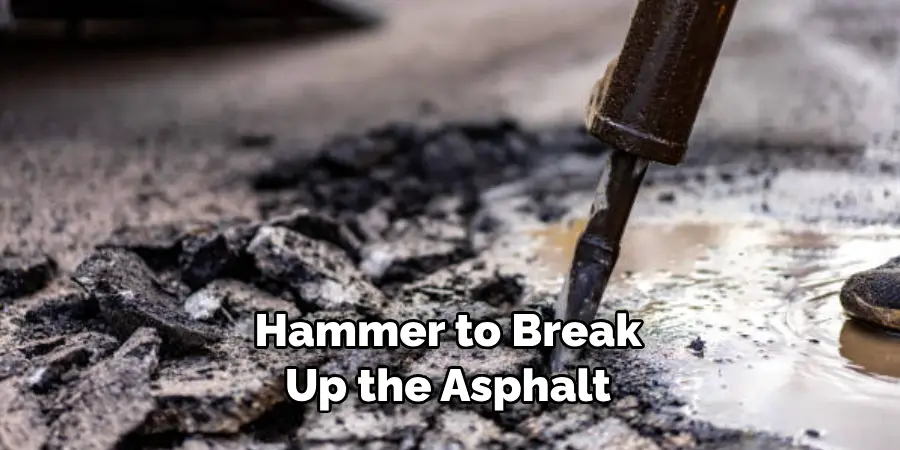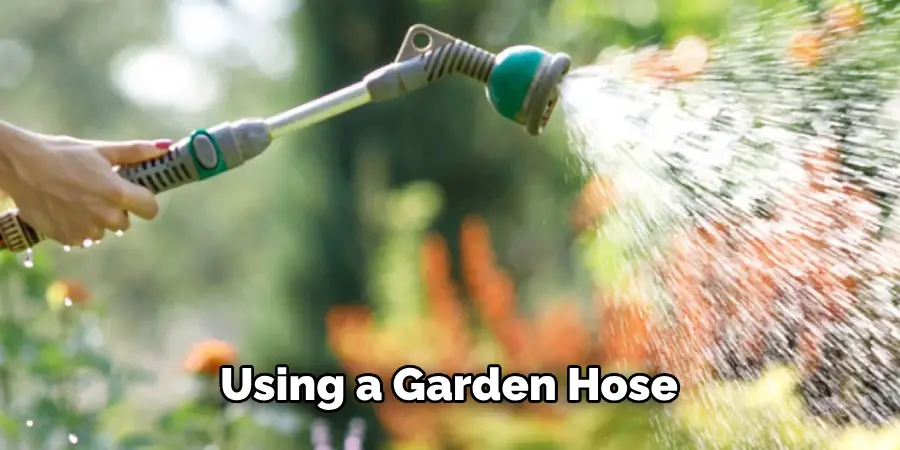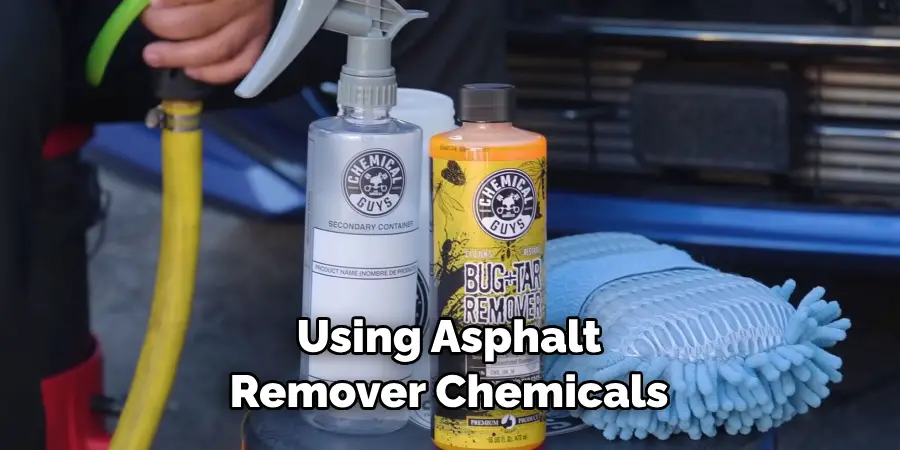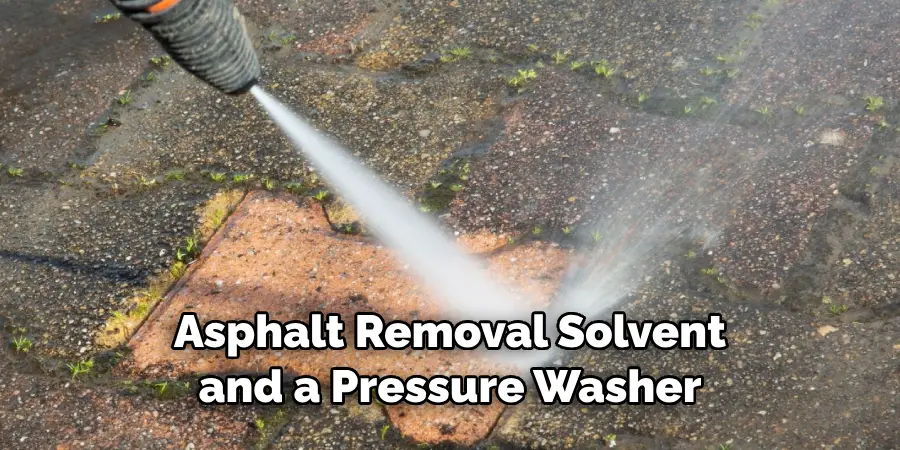Are you looking for an efficient and effective way to remove asphalt from concrete surfaces? Removing asphalt can be a tricky job, as concrete and asphalt are two different materials. Asphalt needs to be removed with care, using the right methods and equipment to prevent any damage being caused to the concrete surface.

In this blog post, we’ll go through the step-by-step process of how to remove asphalt from concrete safely and easily – so read on and discover all you need to know about removing asphalt!
Tools and Materials You Will Need to Remove Asphalt From Concrete
- Protective clothing and gloves
- Safety glasses
- Heavy-duty chisel or large flathead screwdriver
- Hammer
- Vacuum cleaner with a HEPA filter
- Asphalt remover chemicals such as MEK or Xylene
- Broom/brush and dustpan
- Garden hose (with adjustable nozzle)
- Water
- Pressure washer (optional)
Step by Step Guidelines on How to Remove Asphalt From Concrete
Step 1: Prepare the Area for Asphalt Removal
Before beginning the process of removing asphalt from concrete, it is important to prepare the area first. Make sure you are wearing protective clothing and gloves, as well as safety glasses to protect your eyes from any debris that may be created during removal. Preparing the area also includes clearing away any debris or furniture that may be in the way of removing asphalt.
Step 2: Break Up and Remove Asphalt with a Chisel
The next step is to use a chisel, large flathead screwdriver, or hammer to break up the asphalt. If necessary, use a hammer to assist with breaking apart larger pieces. Make sure to take your time and chip away at the asphalt slowly and carefully. This is to ensure that you do not damage the concrete surface.

Step 3: Vacuum Up Loose Asphalt
Once the asphalt has been broken apart and removed, it is important to vacuum up any debris and loose pieces of asphalt from the concrete surface. This should be done with a vacuum cleaner that has a HEPA filter attached. This will help prevent any remaining particles of asphalt from becoming airborne.
Step 4: Treat the Asphalt Remaining on Concrete Surface
If there is any asphalt remaining on the concrete surface, it should be treated with an appropriate chemical remover. MEK or Xylene are two commonly used chemicals that can effectively remove asphalt or oil stains from concrete surfaces. Apply the chemical to the remaining areas and let it sit for several minutes before scrubbing with a brush or broom.
Step 5: Rinse the Area With Water
Once you have removed as much asphalt as possible, it is important to rinse the area with water. This should be done by using a garden hose with an adjustable nozzle setting on low pressure. This will help move any remaining particles away from the concrete surface and will also help neutralize any remaining chemical residue.

Step 6: Pressure Wash (Optional)
If you have access to a pressure washer, this can be used to ensure the area is completely free from asphalt. Make sure that you use it correctly in a low-pressure setting, as using too much pressure can cause damage to the concrete surface. This will also help to remove any chemical residue from the surface.
By following these steps, you should be able to successfully remove asphalt from concrete surfaces with ease! And for more information on the removal of asphalt and other difficult stains from concrete, contact your local contractor or power-washing specialist today. They will be able to provide you with the necessary advice and services needed to get the job done right!
Additional Tips and Tricks to Remove Asphalt From Concrete
- For more stubborn asphalt spots, try using a wire brush to scrape them off the surface of the concrete. Be sure to clean up any loose debris or dirt that is being removed from the asphalt as you go about this process.
- Another helpful tool is a pressure washer, which can help loosen and remove asphalt from concrete quickly and effectively. Be sure to take extra caution when using a pressure washer, as it can damage the surface of the concrete if used improperly.
- If you need to remove asphalt that has been built up over time, use a jackhammer or hammer drill to break into the asphalt and chip away at it in pieces. This will require some physical strength and may be loud, so be sure to wear proper safety gear.
- For more sensitive concrete surfaces, like driveways or sidewalks, you may try pouring hot water onto the asphalt spot and then scraping away at it with a flat shovel.
- Finally, consider using asphalt remover chemicals to help dissolve the asphalt from concrete safely and effectively. Be sure to read the instructions and safety precautions provided on the package before using the product.

With these tips and tricks, you should be able to effectively remove asphalt from your concrete surfaces without causing any damage. Good luck!
Things You Should Consider to Remove Asphalt From Concrete
1. Consider the Size and Scope of the Job:
Before you begin any project, it’s important to assess how much work is needed to get the job done correctly. For example, if you are removing asphalt from a small sidewalk or patio, a few basic tools such as an electric or pneumatic chisel and hammer could suffice. However, if you’re removing asphalt from a large surface area like a driveway or parking lot, more specialized equipment may be needed.
2. Choose the Right Type of Tools:
Once you’ve determined the size and scope of your project, it’s important to choose the right type of tools for the job. This will vary depending on what kind of material you are removing. For example, if you’re working with asphalt, an electric chisel or air hammer may be the best choice. On the other hand, for concrete, a jackhammer might be more appropriate.
3. Be sure to Wear Protective Gear:
When working with any type of demolition tool, it’s critical to wear protective clothing and equipment. This includes long pants, a hard hat, safety glasses, steel-toed boots, and gloves. Additionally, you should make sure you have a dust mask to protect your lungs from particulate matter that may be released during the process of removing asphalt from concrete.
4. Consider Hiring A Professional:
Removing asphalt from concrete can be a tricky and hazardous job. If you don’t feel comfortable tackling the task yourself, it may be worthwhile to consider hiring a professional. They are likely to have the right types of tools and safety equipment that can help ensure the job is done properly and safely. Additionally, they may also be able to offer valuable advice on how best to tackle larger jobs or those that require more specialized techniques.
5. Be Mindful of Your Local Regulations:
In some areas, there may be local regulations in place regarding the disposal of asphalt and other demolition materials. Make sure you are aware of any such rules before beginning your project to ensure that you aren’t in violation of any laws or ordinances. If in doubt, it’s best to consult your local building department for more information.
By considering these points when removing asphalt from concrete, you can rest assured that the job will be done safely and correctly. With the right tools and safety precautions in place, you can complete your project with confidence!
Frequently Asked Questions
What is the Best Way to Remove Asphalt From Concrete?
The best way to remove asphalt from concrete is by using an asphalt removal solvent and a pressure washer. This method will safely break down and dissolve the asphalt, allowing it to be easily rinsed away with water. It is important to always wear protective gear such as gloves, eye protection, and a respirator when using an asphalt removal solvent.

Is Asphalt Removal From Concrete Difficult?
Asphalt removal from concrete can be difficult depending on the size of the area and the amount of asphalt that needs to be removed. Large areas or thick layers of asphalt will require more time and effort to remove than smaller areas with thin layers. It is important to make sure you have the proper tools and safety equipment before attempting this task.
What Are the Benefits of Removing Asphalt From Concrete?
Removing asphalt from concrete can provide many benefits, such as improving the appearance and function of the concrete surface, increasing the lifespan of the concrete, and making it easier to clean. Removing asphalt from concrete can also help prevent any further damage that may be caused by moisture or other elements.
Are There Any Safety Precautions I Should Take When Removing Asphalt From Concrete?
Yes, it is important to always wear protective gear such as gloves, eye protection, and a respirator when using an asphalt removal solvent. Make sure the area is well-ventilated, and take caution not to get any of the solvents on your skin or in your eyes. Also, make sure to read and follow all instructions on the product label before use.
Conclusion
Working with asphalt can be an intimidating job that requires the right know-how, but if you break it down into smaller steps and take your time, you can successfully remove asphalt from concrete surfaces. With the tips and tricks outlined in this article as a guide, you should have enough knowledge about how to remove asphalt from concrete.
To ensure a thorough concrete surface that is rid of asphalt, taking the advice of professional contractors or home improvement stores may also be useful in helping turn difficult projects into easier ones. Don’t forget to also cover different methods when it comes to disposing of the remaining asphalt residue. Taking these extra steps is the key to achieving success with any asphalt-related project. It’s now your turn to put knowledge into practice and experience the result for yourself! Get started today and see what wonders you can do!
